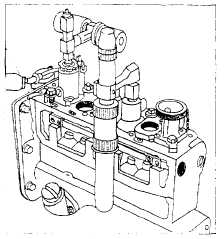pump, as shown in figure 5-8. Remember, bleed the air from the pump and the collector assembly during the priming. After the priming, remove the collector jar and drain. Reset the counter to zero and attach the collector jar to the collector assembly. Operate the pump the prescribed number of discharge strokes. Remove the collector jar and place it on a level surface. The fuel level in the jar is to read from the bottom, as shown in figure 5-9.
The condition of the pump is indicated directly by the calibrations on the collector jar. If the fuel level is within or above the GOOD range, the pump is equivalent to a new one. A fuel level within or below the POOR range shows that the pump plunger and barrel have worn so much that the engine will be hard to start and may have less power. Such pumps should be replaced.

Figure 5-9.-Correct level in collector jar.
Capsule Type Injector Valve. - Capsule type fuel injection valves can be tested on the fuel injection tester for spray characteristics valve opening pressure, and leakage rate. Before testing the valve, inspect the screen filter. (See fig. 5-2.) If the screen is broken or clogged with the dirt particles, discard the valve.
NOTE
NEVER clean the injection valves with a wire brush. The use of a wire brush to remove carbon from the injection valves might damage the orifice and reduce power output.
After inspecting the valve screen filter and cleaning the injector valve nozzle, test the valve for spray characteristics. A solid stream of fuel with little or no atomization is caused either by a gummy carbon accumulation or a particle of foreign material.
If the fuel emitted is properly atomized and the cutoff is sharp with no dribble, the spray characteristics of the valve are satisfactory. When cleaning thc deposited carbon from the injection valve nozzle (fig. 5-10), use a drill from the cleaning tool group kit, furnished by Caterpillar, that corresponds to the orifice size of thc nozzle. The orifice size is usually stamped on thc side of the valve.
Next, test the valve for opening pressure and leakage. Valve opening pressure ranges from 400 to 800 psi, as registered on the test gauge. If the injection valve fails to reach a minimum of 400 psi, observe the gauge to note any drop in pressure. If the pressure falls more than 100 psi in 30 seconds, discard the injection valve nozzle.
Compact Fuel System
The pressure type of compact fuel system has a separate injection pump and injection valve for each cylinder. Fuel is injected into a precombustion chamber (fig. 5-11). A transfer pump delivers filtered fuel to the manifold from which the injection pumps get their fuel. The transfer pump supplies more fuel than is required

Figure 5-10.-Cleaning capsule type of nozzle.

Figure 5-8.-Collector assembly and jar.
Continue Reading